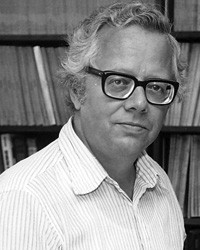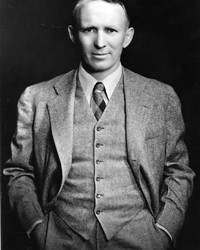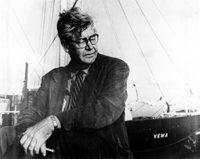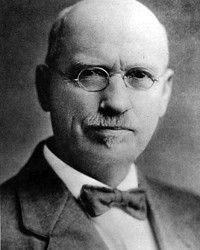Jackson School Inducts Four Legends into Hall of Distinction
March 3, 2011
March 3, 2011
The Jackson School established its Hall of Distinction in 2005 to recognize individuals who are or were strongly affiliated with the school and who achieved exceptional standing in industry, government or academia. This spring, we induct four extraordinary geoscientists into the Hall of Distinction. They join 21 previous inductees.
If you would like to nominate someone for this honor, contact the Jackson School Development Office to request a nomination form.

Milo Backus went to work for Geophysical Services Inc. in the mid-1950s, just as that company was deploying a new game-changing tool in the hunt for oil and gas: digital seismic technology. It was a ball he was ready to run with. According to Robert Graebner, senior research fellow at the Bureau of Economic Geology, Backus was “the chief architect and creator of the ensuing revolution, especially in the development of the applications of signal processing technology that suddenly opened so many new windows to the secrets of the subsurface.” Later, he thought through and led the development and promotion of the practical application of 3-D methods to exploration and production.
Backus has been a geophysicist of international stature from virtually the moment he received his doctorate from MIT in 1956. He helped develop offset dependent reflectivity as one of the most important items in the explorationist’s toolbox. Along the way, he did research that ranged from antisubmarine warfare to fundamental wave propagation. Starting in 1975, he has served as a professor and then emeritus professor at UT Austin. Since 1998, he has also served as senior research scientist at the Bureau.

Ronald K. DeFord joined the University as a professor in 1948 with the purpose of enhancing the quality of the graduate program of the department. He was graduate advisor in the department from 1949 to 1967. He supervised a phenomenal 19 Ph.D. dissertations and 126 master’s theses. He encouraged all students to acquire an adequate foundation not only in geology, but also in mathematics, physics, chemistry, English, foreign language, and fine arts. He led the graduate course called Technical Sessions in which each student is required to make at least one formal presentation of research results to students, faculty, and others. DeFord used the course to teach clear, effective speaking, and graduates have often attributed their successes in lecture presentations to the high standards he so ably imparted.
DeFord was born in San Diego, California on January 22, 1902. In 1922, he earned an MS degree in geology from Colorado School of Mines. He was an honorary life member of the American Association of Petroleum Geologists. He was awarded the title of “Professor Extraordinario” by La Universidad Nacional Autonoma de Mexico in 1968. DeFord died on May 7, 1994.

W. Maurice (“Doc”) Ewing was born in Lockney, Texas, on May 12, 1906. He received a Ph.D. from Rice Institute in 1931. In 1949, he founded Columbia’s Lamont Geological Observatory (later Lamont-Doherty Geological Observatory). In 1972, he returned to Texas to establish a research unit at UT’s Medical Branch at Galveston that would eventually become the Institute for Geophysics.
was born in Lockney, Texas, on May 12, 1906. He received a Ph.D. from Rice Institute in 1931. In 1949, he founded Columbia’s Lamont Geological Observatory (later Lamont-Doherty Geological Observatory). In 1972, he returned to Texas to establish a research unit at UT’s Medical Branch at Galveston that would eventually become the Institute for Geophysics.
Ewing’s greatest love was the study of the character, structure, composition, and origin of ocean basins. For this task he used reflection and refraction seismology, gravity, heat flow, magnetic observations, and sediment samples. Among his contributions are the discovery of the Sigsbee salt-cored knolls in the Gulf of Mexico; the SOFAR channel, a continuous layer in the ocean where sound energy is trapped by focusing, thus providing a mechanism for long-range communications; invented and encouraged the use of the piston corer and deep-sea camera; and collaborated on the invention of a long-period seismograph that helped define the velocity structure of Earth’s outer layers.
He published more than 350 papers and was chief scientist on more than 50 cruises. He was awarded 11 honorary degrees by universities in the U.S. and four foreign countries. He also received 15 major medals and prizes. He died on May 4, 1974.

Johan A. Udden, director of the Bureau of Economic Geology from 1915-1932, advised the Regents of the University in 1916 of the probable occurrence of oil and gas in the University lands of west Texas, a discovery with a tremendous impact on the financial security of the University over the next century. He recognized the potential value of well cuttings in a variety of geological endeavors and demonstrated this to the oil industry by establishing the first subsurface geology laboratory. In 1914 from a study of cuttings from a deep well in West Texas, he discovered extensive deposits of potash salts in the Permian basin.
Udden was born in Sweden on March 19, 1859. Two years later he came to the U.S. with his parents, who settled in Minnesota. He received an MA degree from Augustana College in 1889, where he taught natural science and geology until 1911. Although giving temporary service in 1903-1904, his permanent connection with UT began in 1911 and continued until his death on January 5, 1932. In recognition of his distinguished service in science, Udden was knighted in 1911 by King Gustavus Fifth of Sweden.
by Marc Airhart
For more information about the Jackson School contact J.B. Bird at jbird@jsg.utexas.edu, 512-232-9623.
